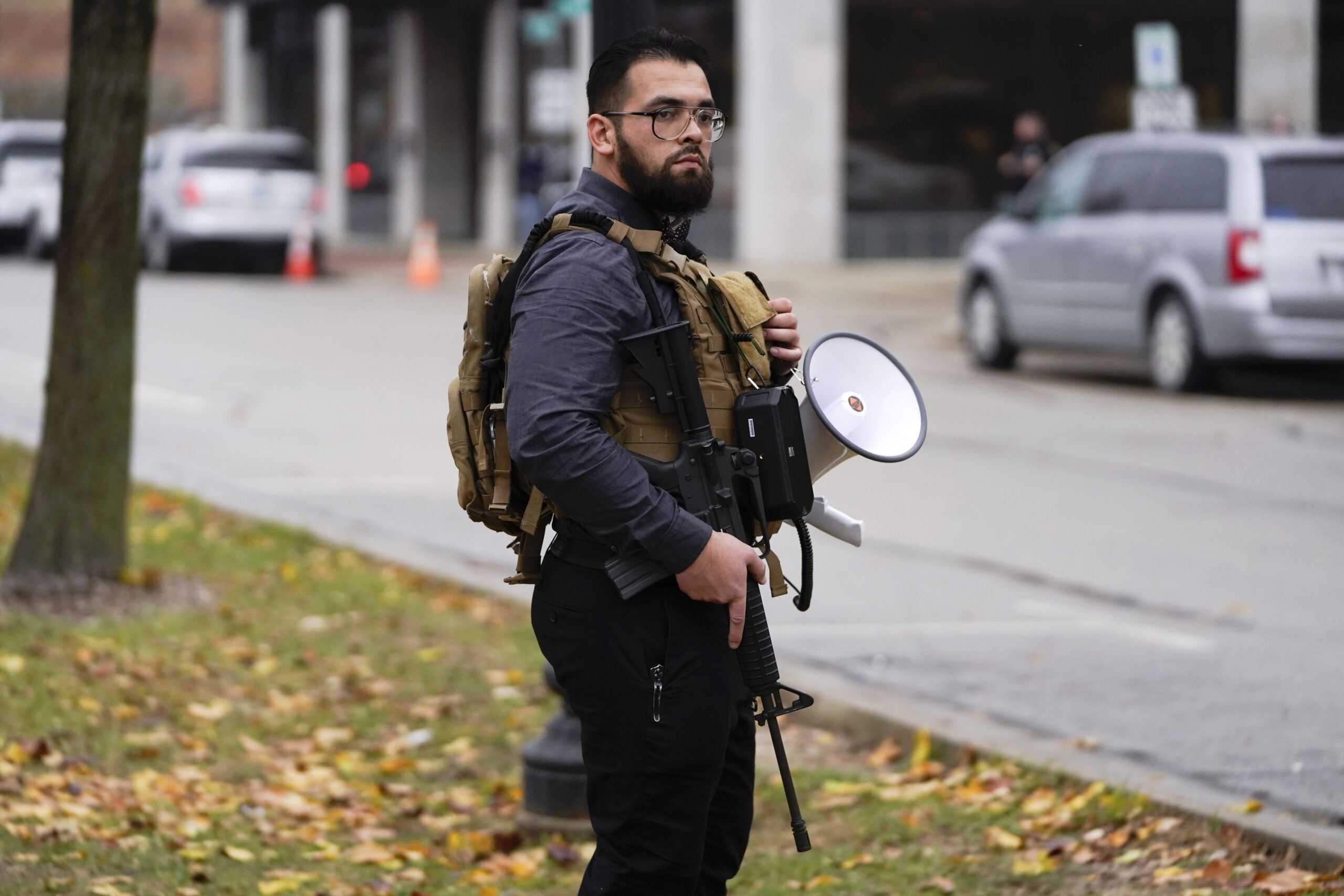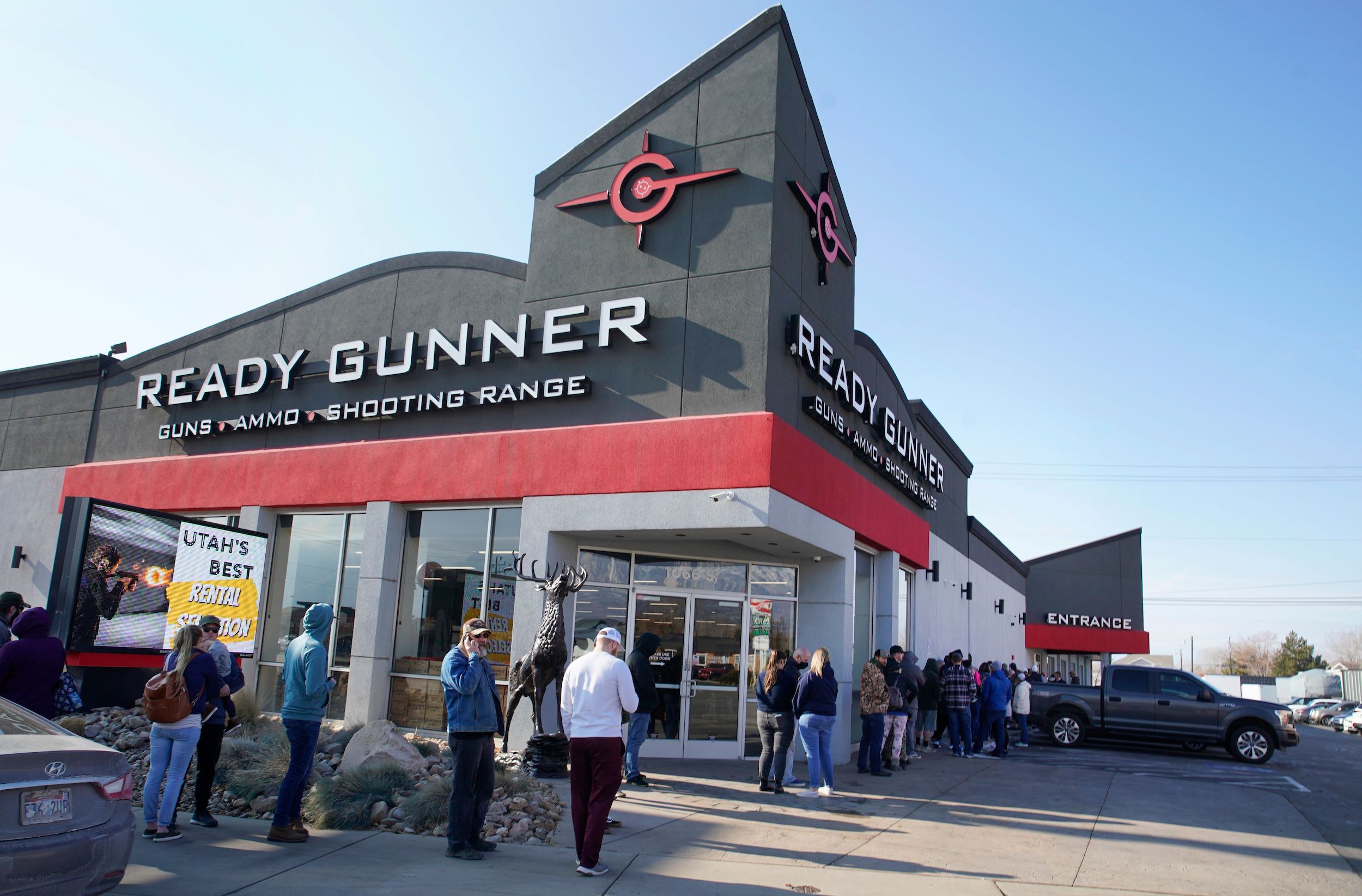It’s been more than two years since a police officer fired seven shots into the back of 29-year-old Jacob Blake, Jr., setting off days of protest in the small Wisconsin city of Kenosha, and making it a lightning rod for nationwide tensions. Amid the unrest, a call to arms was made by Kevin Matthewson, a former Kenosha alderman who created a Facebook page called “Kenosha Guard — Armed Citizens to Protect our Lives and Property.” It attracted armed counter protesters, including Kyle Rittenhouse, a teenager who arrived with a semiautomatic rifle and killed two men and wounded a third.
In November 2021, Rittenhouse was acquitted of all five charges stemming from his actions, including two counts of homicide, two counts of reckless endangerment, and a weapons charge. But the jury’s finding that Rittenhouse — who used a scoped, AR-15-style rifle acquired from a friend — acted in self-defense only deepened Kenosha residents’ concerns about the city’s treatment of Black residents, repression by law enforcement, and the role of guns. As community members and leaders continue to grapple with local policies and legislation around firearms, it is the events of the summer of 2020, and the Rittenhouse shootings in particular, that define the conversation.
“We went back to the ’50s, ’40s, the 1920s,” said Kyle Johnson, a member of Black Leaders Organizing Communities (BLOC), a community advocacy group in Kenosha. “They tried to turn Kenosha into a sundown town before our very eyes,” he said, referring to the whites-only towns of the Jim Crow era and afterward, where segregation was enforced after dusk.
“So many of us were there when the verdict came down,” said Erica Ness, director of community engagement and operations at Leaders of Kenosha (LOK), a nonprofit dedicated to social justice. She recalled the opposing crowds that gathered in and outside of the courtroom, and a man speaking to the crowd after the verdict was announced, defending the decision and saying, “‘The only ones who are guilty are us, because we weren’t there with him shooting.’ And they all cheered.”

For Ness, it was a chilling statement underscoring a shared fear: After the Rittenhouse shootings, the militias never left Kenosha.
BLOC organizer Kyle Johnson is a gun owner who advocates for responsible gun ownership. But the shooting of Blake, ruled as justified by the Kenosha County District Attorney’s Office in 2021 — and the protests that followed — amplified another dimension of public safety that people often overlook, he said. “Police shootings are also gun violence,” said Johnson, pointing to community fears of active, militia-style organizations in the area, as well as concerns that those groups at times work in tandem with police.
The public understanding of the relationship between law enforcement and armed vigilantes in Kenosha, revealed most acutely in the summer of 2020, is one of the most haunting traces left by the Rittenhouse shooting in the community.
“Why wouldn’t they still be here?” Johnson said, referring to the armed groups. “The government hasn’t done anything.”
Just before the shooting, Rittenhouse and a group he was with received water and praise from police in an armored vehicle, and text messages obtained by the Wisconsin Examiner showed that officers regarded the armed groups as friendly, and were aware of escalating activity — including militia members slashing the tires of Black Lives Matter protesters — just half an hour before the shooting. After Rittenhouse fired his rifle, police allowed the teen to leave the scene and the city. Rittenhouse traveled back across state lines to his hometown of Antioch, Illinois, where he turned himself in.
But text messages obtained by the Examiner suggested the tolerance went deeper. “If problems arise and those groups enter into the mix please provide the verbal orders to stand down if we have the resources to handle the calls for service,” Sergeant Adam Jurgens wrote within the Kenosha Police Department’s internal messaging system. “Very friendly but we need to handle our business in-house as much as possible.”
Federal law enforcement agencies pointed to Wisconsin’s open carry law when debriefing one another on their response to armed groups that night. A redacted U.S. Marshals Service communication obtained by the Examiner noted that marshals responded to “multiple, armed subject calls and vehicles of armed people roving neighborhoods.” Although people in those groups were identified by the marshals, no arrests were made. “Wisconsin is an open carry state,” a marshal wrote.
Meanwhile, both federal and local law enforcement disrupted even peaceful Black Lives Matter protest groups using tear gas and rubber bullets and engaged in targeted arrests in unmarked vehicles, surveillance, and other tactics. As the violence unfolded, federal officers of the Marshals Service discussed with one another how the protests and unrest could be used to accumulate resources which could then be steered toward other violent crime operations in southeastern Wisconsin.
Tanya McLean, executive director of LOK, noted that about 100,000 people live in Kenosha, about one-fifth the size of Milwaukee, yet “there’s two to three shootings a week,” she said. McLean and other community organizers feel the city government is more concerned about keeping the issues quiet in order to protect property values and development, rather than addressing systemic problems.
McLean, Ness, and several other Kenosha residents joined Johnson for a private group interview in August, marking the anniversary of the unrest.
“It’s emboldened all the Kyle Rittenhouse supporters and given them a green light to say, ‘Oh, we can do this and we’re going to be lauded as heroes,’” said Ness.
Reflections of that angst appeared in June, during a meeting of the County Board of Supervisors, when the public was invited to comment on a resolution that would allow people to carry weapons into county buildings. Many Kenosha residents arrived to speak both for and against the measure. Among them was Matthewson, the former alderman who had invited armed citizens to come defend the city from protesters. On August 25, 2020, just hours before the Rittenhouse shooting, Matthewson emailed then-Kenosha Police Chief Daniel Miskinis: “We are mobilizing tonight and have about 3,000 RSVP’s… I ask that you do NOT have your officers tell us to go home under threat of arrest as you have done in the past.”
During the June meeting, Matthewson argued that the resolution wasn’t just about keeping guns off county grounds, instead arguing, “It’s that they don’t want guns in the hands of any of us, period.” Matthewson’s supporters in the audience muttered “lies” as the former alderman alluded to “crazy people” and pointed behind him at audience members who were against allowing guns on county grounds. He went on to suggest that gun-free school zone policies should be reevaluated.
But for many other residents who spoke, it wasn’t Second Amendment rights they felt needed defending. Instead, an overwhelming sense of insecurity rose to the surface, whether in the context of domestic violence or the country’s troubling rate of mass shootings, a small piece of rising rates of nationwide gun violence every year.
Russ Han, a Kenosha resident, brought up the mass shooting at a Virginia Beach municipal building in 2019. “I imagine there are a number of county supervisors over the past couple of meetings who have been wondering why so many Kenosha County residents have appeared to speak in opposition to this resolution,” said Han. He named people who had lost loved ones in mass shootings across the nation, including the killing of 19 children and two teachers in Uvalde, Texas. “The fact is that these ordinances have life-and-death consequences. The encouragement of the carrying of firearms in public facilities endangers county employees and county residents.”
Joel Trudell, a 43-year-old Kenosha resident, also spoke out in opposition to the resolution. “There’s only one person here tonight that brought more guns into our community,” said Trudell, referring to Matthewson. “There’s only one person here that called for a militia, with guns, to come into our community. And what was the result of that? We made national news, we killed people, we shot people.”
Trudell then called attention to the campaign finance support some board members received from the Kenosha County Republican Party when he directly addressed a heckler in the audience. One of the board members told Trudell to “be civil” before he was arrested and forced to the floor. Some residents who attended the meeting appeared to jump on him, in a chaotic scene that laid bare the community tensions that had been mostly dormant since the events of two years ago.
Republican-sponsored measures, including an anti-riot bill that critics said would expose peaceful protesters to felony charges, were proposed specifically in response to the Kenosha unrest, and Wisconsin Republicans have made Kenosha a synonym for chaos and what they claim are Democrats’ soft-on-crime policies. (The anti-riot bill was ultimately vetoed by Democratic Governor Tony Evers.)
Immediately after Trudell’s arrest, the board adjourned the meeting. He was charged with disorderly conduct and resisting an officer, and released from custody the next day. Trudell did not respond to multiple requests for comment.
In a subsequent meeting in early July, the board voted 13-7 to lift the ban on concealed weapons within county buildings, as questions about public safety, how guns fit in, and how best to protect private property and businesses have continued to bleed into one another in the community.
In July, the city of Kenosha’s Common Council discussed passing an ordinance that would make business owners responsible for nuisances or disorderly behavior of patrons. The ordinance was very similar to one passed in the nearby city of Racine. Discussions of the ordinance among Kenosha’s residents started not long after a Racine bar owner’s husband was fatally shot while breaking up a fight outside the establishment. The 42-year-old’s death made the prospect of adopting a similar policy in Kenosha less attractive to business owners and activists alike.
Devynn Johnson, a volunteer at the Grace Welcome Center food pantry who served as a medic during the unrest, decried the ordinances. “The only reason he had gone out into the parking lot to stop the fight was because the city of Racine had told him that his parking lot was his responsibility,” said Johnson, who fears what could happen if a similar ordinance were to pass in Kenosha in the current atmosphere around gun violence and public safety. “So he lost his life going out there to keep his business open.”
Following the August 20 shootings, the Kenosha Police Department posted on its official Facebook page that the shootings occurred during a bar fight. The department went on to post: “This cannot be tolerated as the way things are now. We need community members to step up and talk to police before this stuff happens. Guns don’t belong in bars or in the hands of intoxicated people. Guns shouldn’t be possessed by people who are prohibited from possessing them.”
Kenosha County supervisor John Franco was out of town at the time of the meeting, but spoke of a “profound frustration” among those who promote the expansion of gun rights in society “but are often the last to consider common sense gun safety measures to ensure those rights are used responsibly.”
After the Rittenhouse shootings and the protests that preceded them, Franco said, he has seen conversations around gun ownership become more rooted in fear, whether of an outsider or one’s own neighbors.
“So, is this our future?” asked Franco, who like most other members of the board is worried about how new policies will shape the city. “A dystopian world where every man and woman will have to be armed in order to protect themselves from the potential of deadly violence?”
“All rights come with responsibilities,” Franco added. “No right is absolute.”

